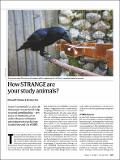Files in this item
How STRANGE are your study animals?
Item metadata
| dc.contributor.author | Webster, Michael Munro | |
| dc.contributor.author | Rutz, Christian | |
| dc.date.accessioned | 2020-06-22T09:30:01Z | |
| dc.date.available | 2020-06-22T09:30:01Z | |
| dc.date.issued | 2020-06-18 | |
| dc.identifier | 268491502 | |
| dc.identifier | a9b72b55-f96a-49d0-a0d6-16f9289db2fb | |
| dc.identifier | 85086621640 | |
| dc.identifier | 000624460200001 | |
| dc.identifier.citation | Webster , M M & Rutz , C 2020 , ' How STRANGE are your study animals? ' , Nature , vol. 582 , pp. 337-340 . https://doi.org/10.1038/d41586-020-01751-5 | en |
| dc.identifier.issn | 0028-0836 | |
| dc.identifier.other | ORCID: /0000-0001-5187-7417/work/75610369 | |
| dc.identifier.other | ORCID: /0000-0001-9597-6871/work/75610552 | |
| dc.identifier.uri | https://hdl.handle.net/10023/20117 | |
| dc.description.abstract | A new framework for studies of animal behaviour will help to avoid sampling bias— ten years on from the call to widen the pool of human participants in psychology research beyond the WEIRD. | |
| dc.format.extent | 4 | |
| dc.format.extent | 5810796 | |
| dc.language.iso | eng | |
| dc.relation.ispartof | Nature | en |
| dc.subject | QH301 Biology | en |
| dc.subject | RC0321 Neuroscience. Biological psychiatry. Neuropsychiatry | en |
| dc.subject | 3rd-NDAS | en |
| dc.subject.lcc | QH301 | en |
| dc.subject.lcc | RC0321 | en |
| dc.title | How STRANGE are your study animals? | en |
| dc.type | Journal article | en |
| dc.contributor.institution | University of St Andrews. School of Biology | en |
| dc.contributor.institution | University of St Andrews. Centre for Biological Diversity | en |
| dc.contributor.institution | University of St Andrews. Centre for Social Learning & Cognitive Evolution | en |
| dc.identifier.doi | 10.1038/d41586-020-01751-5 | |
| dc.description.status | Non peer reviewed | en |
This item appears in the following Collection(s)
Items in the St Andrews Research Repository are protected by copyright, with all rights reserved, unless otherwise indicated.

